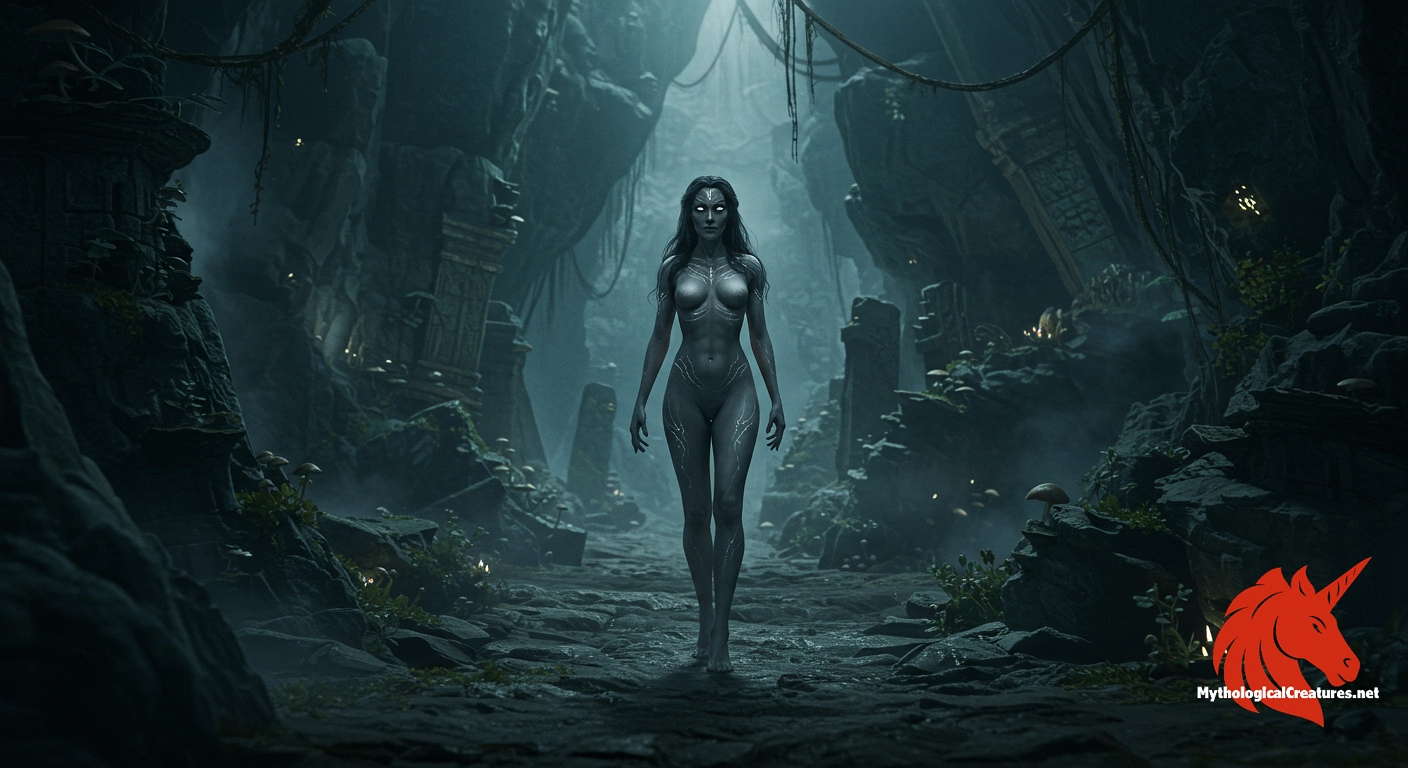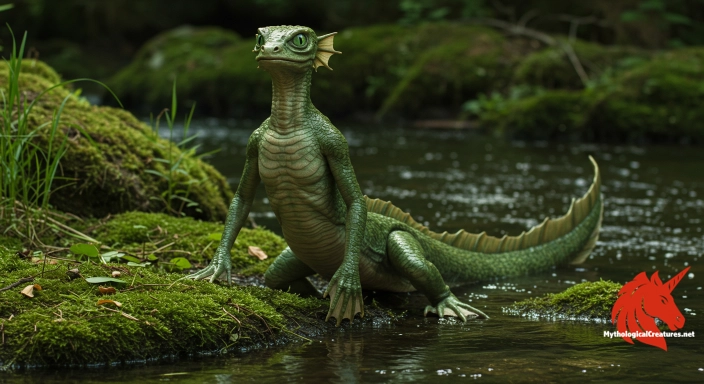Ruha: Ruha is the queen of the World of Darkness in Mandaean mythology, ruling the underworld alongside her son Ur.

Ruha
Ruha - Ruha represents the negative and unclean aspects of feminine power in Mandaean cosmology, serving as a vital force in the balance of cosmic order through her rulership of the underworld.
Origins & First Encounters
Ruha emerges from the mists of Mandaean tradition as a formidable and enigmatic figure, often revered and feared for her dominion over the World of Darkness. Her name, which translates as 'spirit' or 'breath,' hints at a nature that is at once vital and ephemeral. Rooted in an ancient cosmogony, she is intricately woven into the tapestry of myth where darkness and divinity coalesce. Notably, she is also known by the names Namrubs or Hiwat, reflecting the multifaceted layers of her identity. Born of a potent lineage, she is the daughter of Qin, the revered Mistress of Darkness from the earliest underworld realms. Her rule extends to the third ma’darta—an intermediate space often depicted as a purgatory or watch-house—underscoring her connection with both the celestial and the infernal. Beyond her temporal dominion, Ruha embodies the fraught interplay between lust and uncleanness, thereby symbolising the disruptive aspects of feminine power. The enduring narrative of her rise and reign invites contemplation of the moral ambiguities that have long occupied the human psyche.
Source Texts & Tale Variants
Ancient Mandaean scriptures provide the cornerstone for understanding Ruha, with texts such as the Ginza Rabba lending her story both depth and gravitas. These early documents place her within a well-defined cosmological framework where the forces of light and darkness are in perpetual tension. Multiple manuscripts and liturgical recitations also contribute variant strands that paint her as both a seductress and a sovereign of the underworld. In certain accounts, the text vividly delineates her role alongside her son Ur, together forming the dual governance of the nether realms. Oral traditions have further enriched her myth, with local storytellers embellishing her exploits to mirror regional cultural preoccupations. Some narratives intensify her association with the planetary and celestial bodies, linking her directly to the seven planets and twelve constellations as extensions of her power. While core elements remain consistent across texts, subtle differences in detail and emphasis underline the variability of her portrayal over time. These layered sources continue to be a fertile ground for scholars seeking to decode the symbolic language of ancient dualism.
Form & Powers
Despite a primary emphasis on her symbolic dominion, artistic and textual interpretations of Ruha provide evocative glimpses into her physicality. In a number of visual traditions, she is depicted with a luminous yet somber appearance, her aura shifting like the ephemeral glow of twilight. Her figure is often rendered with a fluid grace that suggests both an otherworldly elegance and an unsettling power. Delicate, shimmering garments accompany her form, interwoven with motifs that echo the celestial bodies over which she reigns. Many depictions focus on her eyes, portrayed as deep, reflective pools that hint at secrets buried within the cosmos. The interplay of light and shadow in her countenance mirrors the duality of her nature, embodying both allure and latent danger. Variations in her appearance are not uncommon, with some traditions lending her a more imposing, statuesque silhouette while others opt for a subtler, almost spectral quality. These descriptions, rich in metaphor and symbolism, serve to envelop Ruha in an aura of mystery and dynamic contrast.
Regional Faces
The narrative of Ruha is uniquely sensitive to regional transformations, adapting in tone and detail to the cultural landscapes of the communities that venerate or caution against her. In regions where Mandaeism flourished, particularly within parts of southern Iraq and western Iran, local traditions have highlighted her role as both a dangerous seductress and a paragon of dark regal authority. Variants from these areas often place additional emphasis on her astronomical associations, aligning her imagery with the movements of the stars and the celestial hierarchy. In some local retellings, her depiction becomes more humanised, reflecting a synthesis of myth with the daily experiences of moral and spiritual struggle. The intermingling of regional folklore with established religious texts has given rise to layered interpretations, wherein Ruha’s connection to lust and impurity is balanced by undercurrents of tragic inevitability. As communities passed these stories down through generations, the characteristics of her myth were subtly refashioned to mirror local societal attitudes towards gender, morality, and the supernatural. The resulting mosaic is one where her narrative is not static but a living, evolving dialogue with its cultural surroundings. Such regional adaptations demonstrate the fluidity of myth and the manner in which sacred narratives are continually reinterpreted to engage with contemporary issues.
Cultural Parallels
The complexity of Ruha’s character invites comparison with enigmatic female figures from a broad spectrum of mythologies. In many ways, her dual role as both nurturer and corrupter finds echoes in other ancient narratives where female deities occupy liminal spaces between creation and destruction. Some scholarly discourse draws parallels between her and figures like Lilith or even the more ambivalent aspects of goddesses such as Inanna, who too straddle the realms of divine light and shadow. The recurring motif of a powerful feminine presence who exerts control over chaotic realms can be observed across diverse cultural traditions, ranging from Near Eastern lore to aspects of Gnostic thought. Unlike some counterparts who are primarily symbols of fertility or rebirth, Ruha encapsulates the tensions of moral impurity and carnal desire in a darker, almost subversive manner. Her intertwined relationship with celestial forces further distinguishes her from other underworld deities, giving her an astronomical dimension that enriches her mythos. These intertextual resonances highlight a shared human preoccupation with the dual aspects of feminine power and its potential to disrupt conventional orders. By comparing her with similar figures, one gains insights into the universal themes of transformation, defiance, and the eternal balance between light and darkness.
Legacy & Modern Evolution
The myth of Ruha has journeyed through the ages, its interpretations evolving alongside shifting cultural and religious landscapes. In the earliest Mandaean texts, she was firmly established as a central figure in an elaborate cosmology, embodying the intrinsic conflicts between order and chaos. Over time, however, layers of reinterpretation have emerged, with modern readings often imbuing her narrative with themes of subversion and renegotiation of traditional gender roles. In contemporary art and literature, Ruha is sometimes cast as a symbol of resistance—a powerful antiheroine who challenges societal norms about purity and female propriety. Her portrayal has also been adapted to address modern philosophical inquiries into the nature of desire, moral ambiguity, and the interconnection between the physical and metaphysical. This evolution reflects a broader trend in which ancient deities are re-examined within the context of modern cultural debates. As new academic and creative voices explore her myth, Ruha’s image continues to be transformed, resonating with audiences who see her as more than a relic of a distant past. The modern legacy of Ruha, therefore, is not merely one of preserved antiquity but of ongoing relevance, as she remains a potent symbol that bridges ancient wisdom and contemporary inquiry.
Interesting Fact
Ruha’s multifaceted character blurs the lines between divine rulership and demonic corruption, making her a uniquely complex figure in ancient Gnostic traditions.
Quick Creature Info
Origin:
Associations:
Our Mythic Legendary Rating:

Also Sometimes Known As:
Habitat:
Supernatural Powers:
Physical Attributes:
Abilities:
Behavior:
Weaknesses:
Lore:
Related Creatures, Tales or Lore
References
Discover Another Mythical Legend You May Not Have Heard Of?
Uncover the mysteries of ancient folklore and expand your knowledge of legendary beings from cultures around the world.
Dare to Meet the Kuzenbo....
Mythical Disclaimer: The images and data on this site are derived from various historical and literary sources, but we have found that many myths often have multiple versions and interpretations across references, sometimes contradictory. As a result, these creature depictions are artistic interpretations—imaginative blends of folklore, legend, and a dash of AI guesswork. Because creature descriptions vary widely, our illustrations and accompanying information represent our best effort to honor mythology while bridging creative gaps. Enjoy these interpretations—just remember, we've done our best to respect the stories and validate available data, but in the realm of mythology, details often shift, imagination leads the way, and nothing is ever set in stone!
Curated by the Mythological Creatures Team (rev. May 2025)
